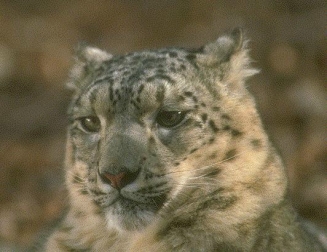|
About snow leopards Snow leopards have a soft gray coat, white on belly. Head and limbs are marked with solid black or brown spots; body is covered with brown blotches ringed with black, and a black streak runs down the back. The snow leopard's coat varies in thickness from summer to winter. A thicker coat in the winter helps to insulate the snow leopard against the cold. |
|
The surfaces of the snow
leopard's paws are covered by a cushion of hair
which increases the surface area of the paws to
allow for better traction in soft snow or on ice.
This added insulation also protects the leopard's
paws from the cold. The snow leopard has a
long tail that helps to maintain balance and
accuracy while jumping. The tail is thickly
furred. When it is very cold, the snow leopard
curls the tail around the body, using the end of
the tail to keep the nose warm. Solitary
creatures, only pairing during the breeding
season. They search for prey along stream
valleys, using ridges and cliffs as a vantage
point from which to spot and ambush prey or to
escape from potential danger. When ambushing their prey, they spring from a distance of 20 to 50 feet. They follow migrating prey along their annual migration routes. Unlike other cats, the snow leopard does not roar and it eats in a crouching position. Snow leopards are considered nocturnal, but seem to be most active in the early morning and late afternoon. They den in rocky caverns and crevices. Extremely rare in most of their range due to the demand for skins. Although trade in snow leopard furs is illegal, it continues to be very active, threatening the snow leopard's existence. An estimated 3,000-10,000 are left in the wild, and about 370 are in captivity. Even though the snow leopard is endangered in much of its range, hunting snow leopards by permit is still allowed in Mongolia where officials believe there are 3000-4000 animals and threaten domestic herds. Combined with human encroachment on their habitat, the snow leopard is disappearing from its wilderness at an alarming rate. Unfortunately, due to the remote habitat of the snow leopard, populations and life history are not well understood. |
